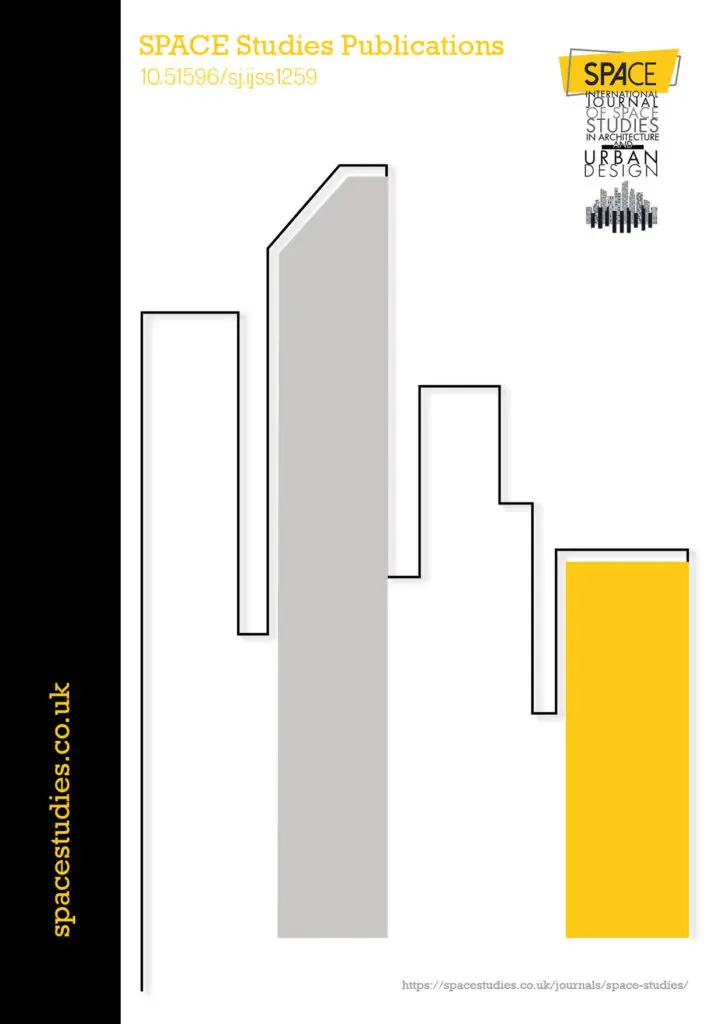Endnotes
This paper was presented at the SPACE International Conference 2022 on Architecture, Building, and Construction and selected for publication in this Journal.
References
Agha, Rand HM (2016), “The role of intelligent systems in traditional courtyard houses in Baghdad, Iraq” Newcastle University, School of Architecture, Planning and Landscape, PhD Thesis, http://theses.ncl.ac.uk/jspui/handle/10443/4063
Al-Muqaram, Asmaa M.H, Al Dabbagh, Shamael M.W, Shatha F. and Al-Bahadly, Hussein (2016), “Adaptive Reuse in Valuable Building Through the Adoption of Change in the Circulation Configuration” Engineering and Technology Journal, Vol 34, Issue 6 Part (A) Engineering, p180-199, https://www.iasj.net/iasj/issue/6887
Amirhosein Ghaffarianhoseini, Umberto Berardi, Husam AlWaer, Seongju Chang, Edward Halawa, Ali Ghaffarianhoseini & Derek Clements-Croome (2016), What is an intelligent building? Analysis of recent interpretations from an international perspective, Architectural Science Review, Vol 59, Issue 5, p 338-357, https://doi.org/10.1080/00038628.2015.1079164
Bell, Tom (2019), 5 Key Benefits of Smart Buildings, trueoccupancy.com, https://www.trueoccupancy.com/blog/5-key-benefits-of-smart-buildings
Brambley, M.R., Haves, P., McDonald, S.C., Torcellini, P.A., Hansen, D.G., Holmberg, D.G., & Roth, K. (2005). Advanced Sensors and Controls for Building Applications: Market Assessment and Potential R&D Pathways, Semanticscholar, https://doi.org/10.2172/1217909
CABA Continental Automated Building Association. (2002) Best-practice guide for evaluating intelligent building technologies. Ottawa, Canada.
Clements-Croome, D. J. 2013. “Sustainable Healthy intelligent Buildings for People.” In Intelligent Buildings: Design, Management and Operation. 2nd ed., p 1–24. London: ICE Publishing. http://dx.doi.org/10.1680/ib.57340.001
Clements-Croome, D. J. 2018, Research Roadmap for Intelligent and Responsive Buildings, CIB General Secretariat, ISBN 978-90-803022-9-7
Danyal Ahmed (2021) Anthropomorphizing artificial intelligence: towards a user-centered approach for addressing the challenges of over-automation and design understandability in smart homes, Intelligent Buildings International, 13:4, 227-240, https://doi.org/10.1080/17508975.2020.1795612
Derek Clements-Croome (2021) Editorial, Intelligent Buildings International, 13:4, 201-202, https://doi.org/10.1080/17508975.2021.1995955
Dilantha, De Silva and Perera, Kanchana K.S. (2016), “Barriers and Challenges of Adaptive Reuse of Buildings”, Conference: Institute of Quantity Surveyors Sri Lanka annual technical sessions 2016, Retrieved from https://www.researchgate.net/publication/319879628_Barriers_and_Challenges_of_Adaptive_Reuse_of_Buildings
DiLouie, Craig (2008). Lighting controls handbook. Lilburn, Ga. [u.a.]: Fairmont Press [u.a.] p. 239. ISBN 1-4200-6921-7.
Don, Peter (2010) “Characteristics of Traditional Architecture”, Retrieved from DoItYourself.com, https://www.doityourself.com/stry/characteristics-of-traditional-architecture
Douglas, James (2006) “Building Adaptations” Published by Elsevier Ltd. Heriot-Watt University, Edinburgh, UK. ISBN-13: 978-0-7506-6667-1. ISBN-10: 0-7506-6667-6
ECA, 2020, Electrical system, Designing Buildings, Retrieved from https://www.designingbuildings.co.uk/wiki/Electrical_system#:~:text=An%20electrical%20system%2C%20within%20the,that%20consume%20the%20electrical%20energy
Edler, J. and T. Edler. 2006. Message vs. Architecture? Dynamic Media as a Continuation of Architecture. Game Set and Match II: on Computer Games, Advanced Geometries and Digital Technologies: 181-189. Rotterdam: Episode Publishers
Hawkins, Andrew. 2016, “This hoverboard startup wants to create floating cities to combat climate change”. The Verge. Retrieved from https://www.theverge.com/2016/10/27/13418576/arx-pax-floating-cities-climate-change-hendo-hoverboard
Hegazi, Y.S.; Shalaby, H.A.; Mohamed, M.A.A. Adaptive Reuse Decisions for Historic Buildings in Relation to Energy Efficiency and Thermal Comfort—Cairo Citadel, a Case Study from Egypt. Sustainability 2021, 13, 10531. https://doi.org/10.3390/su131910531
Ir. Dr. Sam C. M. Hui, 2016, Intelligent buildings, Faculty of science and technology, GEE5303 Green and Intelligent Building, Thei, http://ibse.hk/GEE5303/GEE5303_1617-09.pdf
James Sinopoli, 2010, Chapter 1 – What Is a Smart Building? Smart Building Systems for Architects, Owners and Builders, Butterworth-Heinemann, Pages 1-5, ISBN 9781856176538, https://doi.org/10.1016/B978-1-85617-653-8.00001-6
John Joseph, 2018, Facility Design and Process Utilities, Biopharmaceutical Processing (pp.933-986), https://doi.org/10.1016/B978-0-08-100623-8.00045-1
Joseph Aamidor, 2016, The three types of smart building systems: the way forward for practitioners and vendors, medium, Retrieved from, https://medium.com/@jaamidor/the-three-types-of-smart-building-systems-the-way-forward-for-practitioners-and-vendors-bccdf9d005f4#:~:text=Open%20in%20app-,The%20three%20types%20of%20smart%20building%20systems%3A%20the,forward%20for%20practitioners%20and%20vendors&text=Information%20system%3A%20Acquires%20data%20from,and%20action%20to%20be%20taken
Kenneth R. Dodson, RLA, and Brad Kincaid, SME, 2021,2021, Thee to Smart Building Technologies, Retrieved from, https://www.cisco.com/c/dam/m/en_us/solutions/smart-building/nb-06-smart-building-technologies-guide/Smart-Building-Guide.pdf
Kerim Yildiz (2004), the Kurds in Iraq: the past, present and future, Pluto Press, ISBN-10: 0745322298, ISBN-13: 978-0745322292
Key Components of Fire Protection Systems, Retrieved from, https://www.facilitiesnet.com/firesafety/article/Key-Components-of-Fire-Protection-Systems–18677#:~:text=Fire%2Dprotection%20and%20life%20safety,%2C%20and%20fire%2Dsuppression%20systems.&text=These%20barriers%20are%20arranged%20to,spread%20of%20a%20standard%20fire
Khoshnaw, Rebaz and Kissfazekas, Kornélia. 2019. Urban form and sustainability in historic cities A case study of two neighbourhoods in Erbil city, Iraq. akjournals. Volume 47: Issue 1-2, https://doi.org/10.1556/096.2018.014
Kurdistan Region Government, Ministry of planning, Regional statistical office. Erbil: statistic year book, 2007.
Kwon, O., E. Lee, and H. Bahn. 2014. “Sensor-aware Elevator Scheduling for Smart Building Environments.” Building and Environment Vol 72, p 332–342. https://doi.org/10.1016/j.buildenv.2013.11.013
Mario, 2021, Video Surveillance Systems, 231 West 29th Street 8th Floor, New York, NY 10001, Retrieved from https://www.buildingsecurity.com/video-surveillance-systems/
Matias Peluffo, 2015, Defining Today’s Intelligent Building, Commscope, Retrieved from https://www.commscope.com/Blog/Defining-Todays-Intelligent-Building/
Mohsen Sheikholeslami Kandelousi, 2018, HVAC System, Intechopen, ISBN: 1789844320, 9781789844320
Mojtaba Navvab, Stefano Panzieri (2019) in Handbook of Energy Efficiency in Buildings, Elsevier Science, ISBN:9780128128183
Osama Omar,2018, Intelligent building, definitions, factors and evaluation criteria of selection, Alexandria Engineering Journal, Vol 57, Issue 4, P 2903-2910, ISSN 1110-0168, https://doi.org/10.1016/j.aej.2018.07.004
Paul Ehrlich, 2007, What Is an Intelligent Building?, 1st Edition, p 6, ISBN: 9781003151234, https://www.taylorfrancis.com/chapters/edit/10.1201/9781003151234-4/intelligent-building-paul-ehrlich
Prihatmanti, Rani and Susan, Maria Yohana (2017), “Adaptive reuse of heritage building and the impact to the visual comfort: Assessed by the lighting quality” IPTEK Journal of Proceedings Series, No 3, http://dx.doi.org/10.12962/j23546026.y2017i3.2443
Rav Panchalingam & Ka C. Chan (2021) A state-of-the-art review on artificial intelligence for Smart Buildings, Intelligent Buildings International, 13:4, 203-226, https://doi.org/10.1080/17508975.2019.1613219
Roth K. W., Westphalen D., Dieckmann J., Hamilton S. H., and Goetzler W. 2003, Energy consumption characteristics of commercial building HVAC systems. 3. Energy savings potential. Us department of commerce, ntis (national technical information service) TIAX LLC 20 Acorn Park Cambridge, MA 02140-2390 TIAX Reference No. 68370-00
Šumak, Boštjan, Saša Brdnik, and Maja Pušnik. 2022. “Sensors and Artificial Intelligence Methods and Algorithms for Human–Computer Intelligent Interaction: A Systematic Mapping Study” Sensors, Vol. 22 Issue 1, p20-20. https://doi.org/10.3390/s22010020
Suzi Mein, 2019, What is a Fire Protection System, Firetrace, Retrieved from https://www.firetrace.com/fire-protection-blog/what-is-a-fire-protection-system
Tam, Vivian W. Y. and Hao, Jane J. L. (2018), “Adaptive reuse in sustainable development”, International Journal of Construction Management, Vol 19, Issue 6, p 509-521, https://doi.org/10.1080/15623599.2018.1459154
Todd Harpel (2019) The benefits of Intelligent Buildings, https://www.nexans.com/business/Telecom—Data/Local-area-network/lan_systems_blog/lan_systems_blog_posts/13.2019-IntelligentBuildings_II_benefits.html
Tom Bell (2019), 5 Key Benefits of Smart Buildings, TrueOccupancy by irisys, retrieved from https://www.trueoccupancy.com/blog/5-key-benefits-of-smart-buildings
Torem, Emily (2017) “Adaptive Reuse Architecture: why, how and when”, Schmidt Associates, Retrieved from http://moss-design.com/adaptive-reuse-architecture/
Yongtao Tan,* Chenyang Shuai, and Tian Wang 2018, Critical Success Factors (CSFs) for the Adaptive Reuse of Industrial Buildings in Hong Kong, international journal for environment research and public health, Vol15, issue 7, https://doi.org/10.3390/ijerph15071546
Yung, Esther H.K. and Chan, Edwin H.W. (2012), “Implementation challenges to the adaptive reuse of heritage buildings: Towards the goals of sustainable, low carbon cities”, Habitat International, Vol 36, Issue 3, P 352-361, https://doi.org/10.1016/j.habitatint.2011.11.001
Disclosure Statement
No potential conflict of interest was reported by the author(s).
Biographical Notes on Contributors
Amna N. Salman is an MSc student in Architecture Engineering at the College of Engineering, University of Baghdad. She earned a bachelor’s in architectural engineering in 2018 and was an assistant in Architecture Engineering at the College of Engineering, Tishq International University. She worked in the practical field as a project manager, architect, and graphic designer. Finally, she participated in many architectural competitions.
Rand Agha is an assistant professor in Development Architecture Engineering at the College of Engineering, University of Baghdad. She received a bachelor’s in architectural engineering in 1995 And a master’s in interior architecture in 2001, both from the University of Baghdad. She also received a PhD in intelligent building in 2016 from Newcastle University in the United Kingdom. She has published many research papers and books. Finally, she has won many prizes in design projects and as a researcher.



